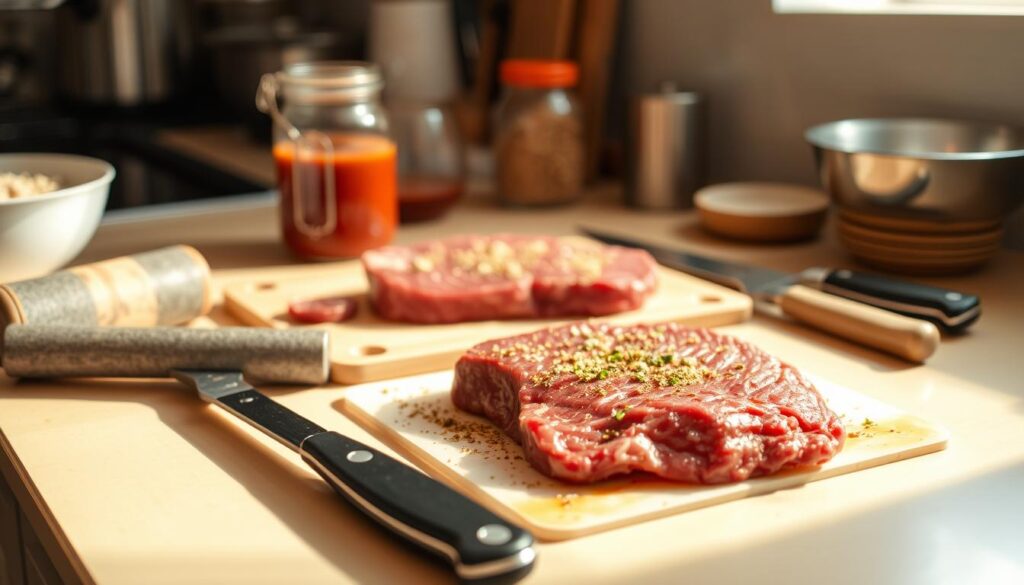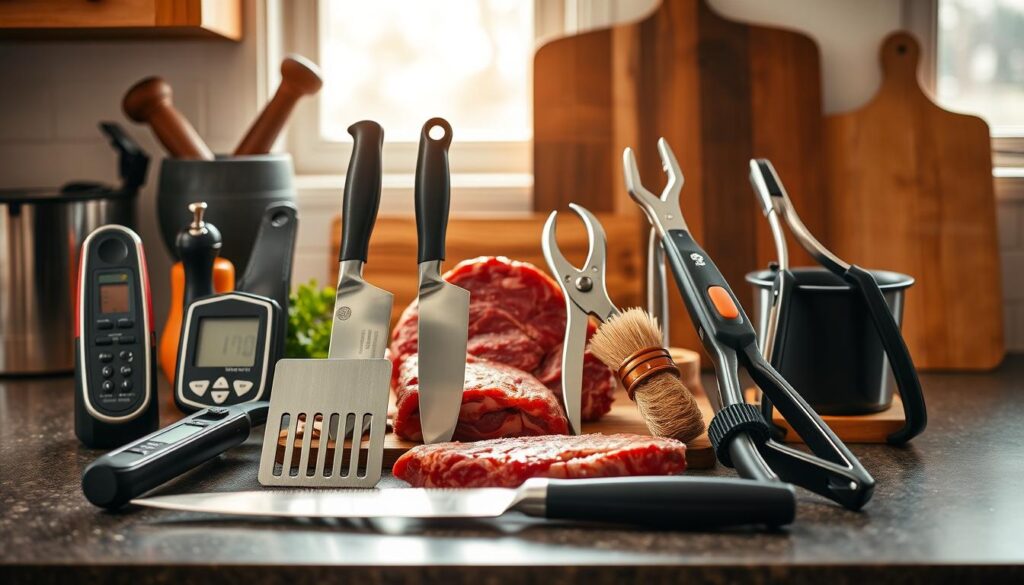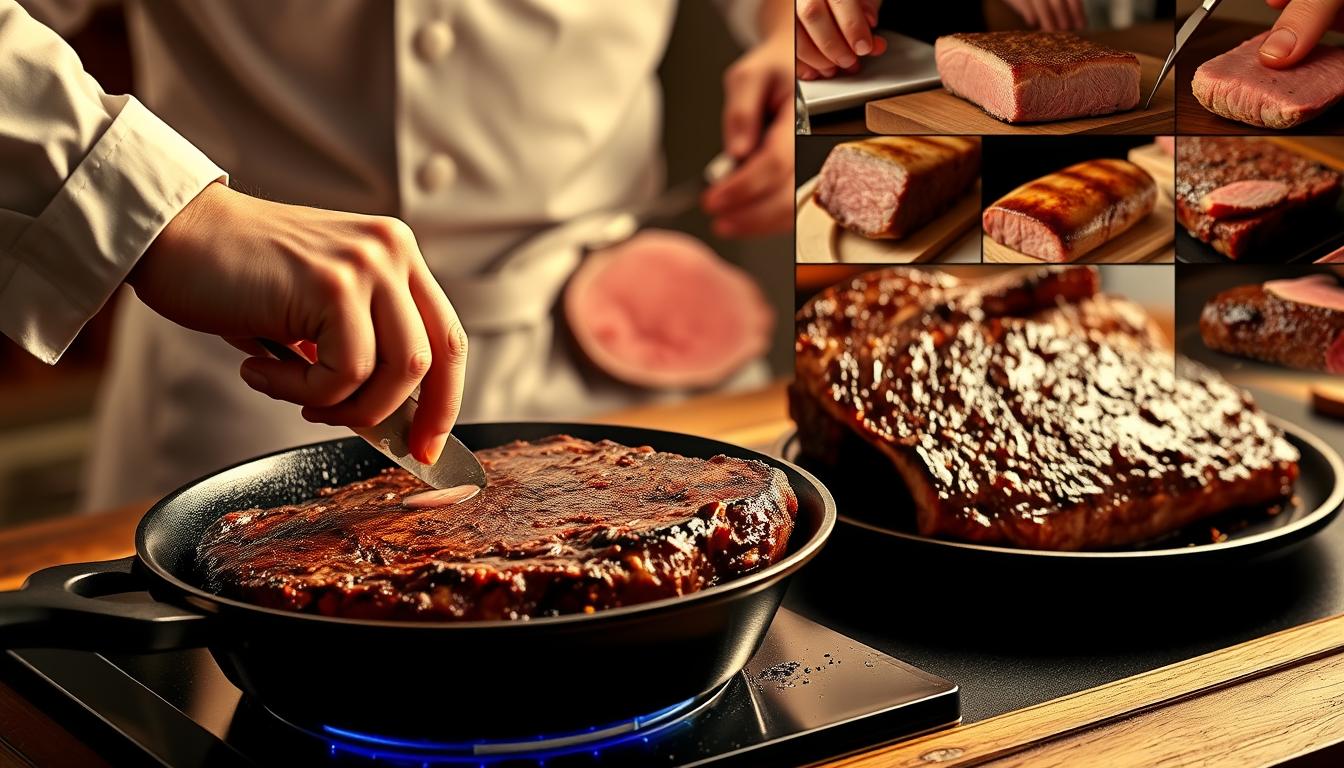Every home cook has faced the disappointment of dry, tough beef. I’ve been there, watching my beef turn tough. But cooking perfect beef is not magic; it’s a skill you can learn.
Beef is a favorite in American kitchens for its rich flavor and versatility. Whether it’s a weekend roast or a quick stir-fry, knowing how to cook beef makes a big difference. These seven methods will help you make beef that’s always tender and juicy.
Mastering beef preparation is an art form, whether in professional kitchens or at home. You’ll learn how to pick the best cuts and control cooking temperatures. This will help you make mouth-watering beef dishes that impress everyone.
Ready to improve your cooking skills and make delicious beef recipes every time? Your journey to becoming a beef cooking expert starts here.
Essential Tips for Perfect Beef Selection
Choosing the right beef can make your cooking amazing. Knowing about beef cuts, nutrition, and quality helps you pick well at the store. This way, you can make tasty meals every time.
Choosing the perfect beef is more than just picking a random package. You must think about several important factors. These factors affect flavor, tenderness, and how good it tastes.
Best Cuts for Different Cooking Methods
Different beef cuts are best for different cooking ways. Here’s a quick guide to help you choose the right cut for your cooking style:
- Grilling: Ribeye, New York strip, and sirloin
- Roasting: Prime rib, tenderloin, top round
- Braising: Chuck roast, short ribs, brisket
- Stir-frying: Flank steak, skirt steak
Understanding Meat Grades and Quality
Beef nutrition starts with knowing meat grades. The USDA grades beef by how much marbling and how old it is:
- Prime: Highest quality with lots of marbling
- Choice: Good quality with some marbling
- Select: Leaner with less marbling
How to Choose Fresh Beef at the Store
When picking grass-fed beef, look for these signs of freshness:
- Bright red color
- Firm texture
- No too much liquid in the package
- Fresh, clean smell
Pro tip: Grass-fed beef tastes stronger and is leaner than grain-fed. It has more omega-3 fatty acids and antioxidants.
The Science Behind Tender, Juicy Beef
Learning about beef cooking can make you a better chef. Beef is made of complex muscle fibers and proteins. When you heat it, these molecules change a lot. Your cooking method affects how tender and tasty the meat is.
Beef changes in several ways when it cooks:
- Protein denaturation breaks down muscle structures
- Collagen converts to gelatin under sustained heat
- Maillard reaction creates rich, complex flavors
Different cooking methods work in unique ways with beef’s cells. Slow cooking breaks down connective tissues, making the meat very tender. High-heat methods like searing quickly change proteins, sealing in moisture and creating a tasty crust.
| Cooking Method | Protein Effect | Tenderness Result |
|---|---|---|
| Slow Cooking | Gradual Collagen Breakdown | Very Tender |
| Searing | Rapid Protein Modification | Moderate Tenderness |
| Braising | Moisture-Assisted Breakdown | Extremely Tender |
Beef is not just tasty; it’s also good for you. It’s full of protein, iron, zinc, and vitamin B12. By knowing the science behind cooking beef, you can make your meals always delicious.
“Cooking is about understanding the science behind ingredients” – Professional Chef
Pre-Cooking Preparation Techniques
Preparing beef for cooking is an art that can make any meal special. It’s key to get tender, flavorful beef that wows everyone. By learning a few techniques, you can make your beef dishes as good as those in restaurants.
Room Temperature Guidelines
One important tip is to let your meat warm up before cooking. Cold beef cooks unevenly, leading to tough results. For the best outcome:
- Take the beef out of the fridge 30-45 minutes before cooking
- Let it sit on a clean plate at room temperature
- Pat the beef dry with paper towels to remove excess moisture
Proper Seasoning Methods
Seasoning can really change how beef tastes. Salt is key for flavor and a great crust. Pro tip: Season your beef with kosher salt about 40 minutes before cooking. It helps break down proteins and keeps the meat moist.
Effective Marinade Recipes
Marinades can make beef taste amazing. A good marinade usually has:
- Acid (like vinegar or citrus juice)
- Oil
- Herbs and spices
- Aromatics like garlic or onion
Here’s a quick marinade for beef: Mix olive oil, balsamic vinegar, minced garlic, rosemary, salt, and black pepper. Coat your beef and let it sit for 1-2 hours before cooking for maximum flavor.
Mastering the Art of Beef Tenderizing

Turning tough beef into tender, tasty meals is key for any home cook. Beef tenderizing techniques can make even cheap meat taste great. This makes cooking beef more fun and flavorful.
There are many ways to tenderize beef, each for different types of meat. Knowing these methods can help you get the perfect texture and taste in your dishes.
- Mechanical tenderizing breaks down muscle fibers
- Chemical tenderizing uses enzymes and acids
- Salt-based treatments help soften meat proteins
Mechanical tenderizing involves physically breaking down tough muscle fibers. Here are some beef cooking tips to help:
- Meat mallet: Pound meat to flatten and soften
- Blade tenderizer: Creates small cuts in the meat
- Scoring surface: Makes shallow cuts to reduce toughness
Chemical tenderizing is another way to soften beef. Acidic marinades with vinegar, citrus, or wine can break down proteins. This improves the meat’s texture.
| Tenderizing Method | Effectiveness | Best Used For |
|---|---|---|
| Meat Mallet | High | Thick, tough cuts |
| Enzymatic Marinade | Medium | Lean meats |
| Salt Brine | Low-Medium | Larger muscle groups |
Be careful not to over-tenderize, as it can make the meat mushy. Always use these techniques with care. This way, you keep the beef’s natural flavor and texture.
Temperature Control Secrets for Perfect Beef
Mastering temperature control is key to making delicious beef dishes. Cooking beef needs precision and knowing internal temperatures for the right doneness. Whether it’s a tender steak or a juicy roast, managing heat well boosts your cooking skills.
Starting with the perfect beef dish means knowing internal temperature guidelines. Different doneness levels need specific heat ranges to turn raw meat into a tasty meal.
Internal Temperature Guidelines
Your kitchen thermometer is essential for beef cooking tips. Here’s a detailed guide to internal temperatures:
- Rare: 125°F (50-52°C) – Deep red center
- Medium Rare: 135°F (57-60°C) – Warm red center
- Medium: 145°F (63-65°C) – Pink center
- Medium Well: 150°F (65-67°C) – Slight pink center
- Well Done: 160°F (71-73°C) – No pink
Cooking Time Charts
| Beef Cut | Thickness | Rare | Medium | Well Done |
|---|---|---|---|---|
| Ribeye Steak | 1 inch | 4-5 minutes | 5-7 minutes | 8-10 minutes |
| Tenderloin | 1.5 inches | 5-6 minutes | 6-8 minutes | 9-11 minutes |
| Sirloin | 1 inch | 4-5 minutes | 5-7 minutes | 7-9 minutes |
Thermometer Usage Tips
For the best beef dishes, follow these thermometer tips:
- Insert the thermometer into the thickest part of the meat
- Avoid touching bone or fat
- Let the meat rest 3-5 minutes after cooking to redistribute juices
- Clean your thermometer between uses to prevent cross-contamination
“Precision is the secret to transforming good beef into an extraordinary meal.” – Professional Chef
Essential Kitchen Tools for Cooking Beef

Mastering beef recipes is not just about skill. You also need the right kitchen tools. The right equipment can make your cooking experience better. It’s all about choosing tools that help with heat, precision, and cooking performance.
Here are the must-have tools for creating delicious beef dishes:
- Cast Iron Skillet: The ultimate pan for even heat distribution and creating perfect sear marks on beef
- Digital Meat Thermometer: Ensures precise internal temperature for ideal doneness
- Quality Tongs: Provides safe and controlled handling during beef cooking techniques
- Sharp Chef’s Knife: Essential for proper beef cutting and preparation
When picking beef cooking tools, look for quality and function. A good stainless steel pan can greatly improve your beef recipes. Chefs say to invest in tools that give consistent heat and let you control the temperature well.
The right tools can elevate your beef cooking from good to exceptional.
For better beef cooking, try using special tools like sous vide machines and slow cookers. These tools let you try new cooking methods. They help you make your beef dishes taste like they’re from a restaurant.
Pan-Searing Techniques for Juicy Results
Mastering pan-searing is key to making delicious beef dishes. The right technique can turn an ordinary cut into a top-notch meal. It’s all about precision, heat control, and preparation.
Heat Management Tips
To get the perfect sear, you need to control the heat. Your pan should be scorching hot before adding the beef. Use a cast-iron skillet or heavy-bottomed pan for even heat.
Preheat the pan for 3-4 minutes on medium-high heat. This creates the best cooking surface.
- Ensure pan is dry before heating
- Use high smoke point oils
- Avoid moving meat immediately after placing
Oil Selection Guide
| Oil Type | Smoke Point | Best for Beef Cooking |
|---|---|---|
| Avocado Oil | 520°F | High-heat searing |
| Grapeseed Oil | 420°F | Quick searing |
| Canola Oil | 400°F | General cooking |
Proper Flipping Methods
Flipping technique is crucial when pan-searing beef. Let the meat get a golden-brown crust before flipping. Use tongs to flip, not a fork, to keep juices in.
Flip most beef cuts only once. This keeps them juicy and creates a great caramelized exterior.
“The secret to perfect beef is patience and heat control.” – Professional Chef
Follow these tips to improve your cooking skills. You’ll make dishes that impress everyone.
Low and Slow Cooking Methods
Turning tough beef into tender meals is all about low and slow cooking. This method is key for making beef recipes tender and flavorful. Cooking beef at low temperatures for a long time breaks down tough fibers, making dishes incredibly tender.
Low and slow cooking is amazing because it turns cheap cuts into gourmet meals. Cuts like chuck roast, brisket, and short ribs become tender and delicious with these techniques.
- Braising: Perfect for creating falling-apart beef dishes
- Slow roasting: Develops deep, complex flavors
- Pressure cooking: Reduces cooking time while maintaining tenderness
When picking cuts for slow cooking, choose meats with lots of connective tissue. These cuts have a lot of collagen that turns into gelatin, making the beef tender. Knowing this science will help you make your best beef dishes.
Pro tip: Always use a meat thermometer to ensure your beef reaches the perfect internal temperature without overcooking.
Liquid is key in slow cooking. Use broth, wine, or a mix to add flavor to your beef. Try different herbs, aromatics, and seasonings to improve your beef cooking.
Quick and Easy Beef Stir-Fry Guide
Stir-frying is a fast way to cook beef recipes. It turns simple ingredients into tasty meals in no time. It’s perfect for busy cooks or anyone who loves cooking beef.
Stir-frying is an art that needs precision and quick thinking. The secret to great beef dishes is in preparation and technique.
Selecting the Perfect Beef Cuts
Choose tender cuts that cook fast and stay juicy. Good options are:
- Sirloin tip
- Flank steak
- Ribeye
- Top round
Vegetable Pairings That Elevate Your Stir-Fry
Choosing the right vegetables can make your beef stir-fry better. Here are some great choices:
- Crisp bell peppers – add color and crunch
- Broccoli florets – soak up sauce well
- Snap peas – add fresh texture
- Onions – boost flavor
Sauce Magic: Creating Flavor Explosions
A great sauce can make beef dishes amazing. Try these sauce ideas:
- Soy-ginger blend
- Spicy Sriracha mix
- Honey-garlic glaze
- Teriyaki-based sauce
“The secret to an amazing stir-fry is high heat and constant movement” – Professional Chef Recommendation
Wok Cooking Pro Tips
You don’t need a wok to stir-fry. Just use a large skillet. The key is high heat, quick cooking, and stirring constantly. This keeps flavors in and meat tender.
- Slice beef against the grain
- Pat meat dry before cooking
- Cook in small batches
- Keep ingredients moving
Resting and Slicing Techniques
Mastering beef cooking tips means knowing how to rest and slice your meat. These steps can turn a good dish into an amazing one.
Resting your beef is key to making the best dishes. When you take meat off the heat, juices are still moving and packed near the top. Letting it rest lets these juices spread evenly, making the meat tender and flavorful.
- Let steaks rest for 5-10 minutes after cooking
- Larger roasts need 15-20 minutes to rest
- Cover the meat loosely with foil to keep warm
Slicing techniques are also crucial. Always cut against the grain for tender bites. This means cutting across the muscle fibers.
Use a sharp knife for clean cuts. A carving knife or chef’s knife is best. Slice beef thinly for tender results, especially with tough cuts like flank or skirt steak.
“The difference between a good and great beef dish often lies in how you rest and slice your meat.” – Professional Chef
By using these techniques, you’ll improve your beef cooking. You’ll impress everyone at dinner.
Conclusion
Your journey into beef cooking is just starting. We’ve covered seven methods to make amazing meals from beef. Whether you cook at home or dream of being a chef, knowing how to choose and cook beef will make you better.
Cooking beef is more than following recipes. It’s about getting better and feeling sure in the kitchen. Every beef cut is different, and trying new ways can bring out the best flavors and tenderness. Remember, the best recipes come from practice, patience, and learning from each try.
For amazing beef dishes, pay attention to every detail. Choose quality meat and control cooking temperatures well. Use good tools, learn about temperature, and try new things. Soon, you’ll make dishes that wow everyone, making meals unforgettable.
Now you know how to cook beef well and creatively. Use what you’ve learned, trust yourself, and enjoy the tasty results of your cooking adventures.

